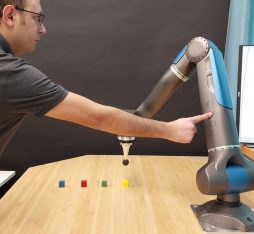• Robots outperform animals on the level of sub-systems in categories like power, frame, actuation, sensing and control, but animals benefit from better integration of all these sub-systems and have superior overall abilities.
• At the same time, animals still dominate performance in some sub-systems: notably in the realm of intelligence (surpassing AI) and their capacity to store and convert energy.
Roboticists are fascinated by octopuses: they can manipulate objects, bend their arms anywhere and in any direction, and they are flexible enough to squeeze into very tight spaces. “We’re still a long way from achieving octopus-like performance in robotics; for the time being, we’re closer to what bees are capable of doing,” explains Samuel A. Burden, an associate professor at the University of Washington (Seattle). Earlier this year, Burden contributed to an article in Science Robotics entitled “Why animals can outrun robots”. Although it may seem outlandish to compare the performance of robots to animals, the researcher explains: “Biology is the only technology to which we have access: it offers proofs of concept with live organisms, living tissue and functional ecosystems.” Throughout the ages and long before Boston Dynamics founder and chairman Marc Raibert started experimenting with biomimetic quadrupeds, roboticists have always sought inspiration in the world of living creatures with the fanciful hope of one day surpassing their biological abilities.
With hardly any exceptions, engineering technologies met or exceeded the performance of biological components in animals
Five distinct sub-systems
“Today, there’s no reason to believe that robots can’t surpass the physical skills of animals,” points out Samuel A. Burden. “Animal muscles are marvellous, but in most of the subsystems that make up a robot, robotics is more powerful.” To reach this conclusion the research team set out to measure the performance of biological components in animals — that is to say animal brains, sensory and vision systems etc. — and to compare them with equivalent mechanical and electronic parts. In particular, they focused on five subsystems that enable a robot to run: power, frame (bones), actuation, sensing, and control. With hardly any exceptions, engineering technologies met or exceeded the performance of their biological counter parts in each of these categories. “However, animals benefit from superior overall integration of subsystems,” points out the researcher. For example, animals use their muscles to exert movement: while some motors are far more powerful than muscles, their torque remains limited without the use of transmission mechanisms. Piezoelectric actuators provide precision control on a limited scale but are not suitable for locomotion. Given these two constraints, it is difficult for robots to achieve the same level of dynamic movement as animals.
A lot more must be done to improve the coordination of robotic subsystems, while animals excel at integrating and controlling their different attributes. On a more hopeful note, the researchers point out that the evolution of animal biology over millions of years has given it a substantial head start over robotics, which has only just begun. At the same time, robotics has the advantage of being able to integrate advances in one robot or subsystem over a wide range of machines and benefits from a multi-directional exchange of principles and approaches that is not constrained by lineage.
Animals are smarter and have more stamina
Having said that, robots would have to be equipped with thousands of pressure and temperature sensors if they are to accede to a level of sensitivity and awareness on a par with animals. The same applies to limb rotation that is accurate to the nearest millimetre, although “soft robotics offers new possibilities, not least because it allows for an infinite number of robot body positions.”
In their analysis of subsystems, the researchers also found that biological energy storage and biological brains outperformed their robotics equivalents. “Cockroaches have more neurons than some of the biggest neuromorphic chips in existence today, which don’t have real neurons in any case.” As for energy storage and the comparison between biological endurance and batteries, the researchers believe that future generations of robots will be equipped with portable mini-power plants that enable them to be more self-sufficient. At the same time, interdisciplinary collaboration between biologists, physicists and engineers may also extend the boundaries of what is currently possible in the field. Last but not least, in a research area which is dominated by design constraints, the continuing introduction of new materials will almost certainly have a transformative influence on the creations that roboticists will soon be able to build.
Image: the robot Spot; Jonte, CC BY-SA 4.0, via Wikimedia Commons
 Sam Burden
Sam Burden











